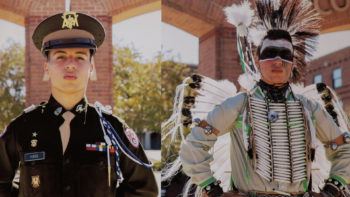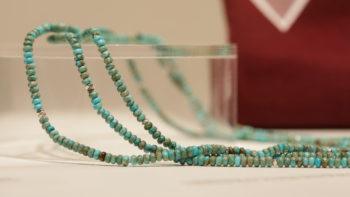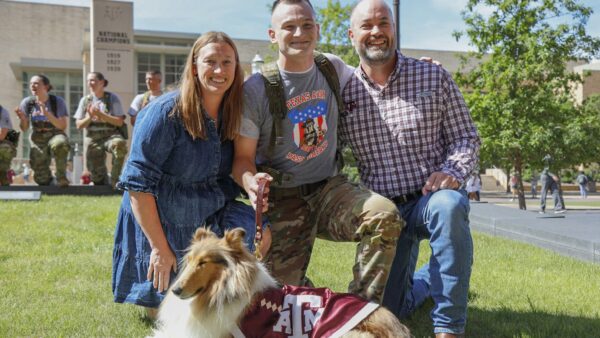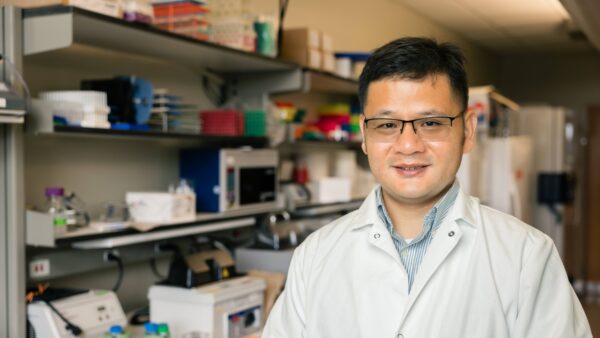New Campus Exhibit Honors Past And Present Native American Aggies

Two photos of Texas A&M University senior George Hass hang side-by-side on a wall of the Forsyth Galleries in Texas A&M’s Memorial Student Center. On the left, Hass is pictured standing at attention in the iconic Corps of Cadets Midnight Uniform. On the right, he stands with his hands on his hips, sporting a set of traditional regalia that he meticulously crafted by hand to honor his Creek and Nez Perce heritage.
“The Corps me that y’all see every day is one side, but this other side with regalia and reverence for the culture is also me,” said Hass. “It may be two sides, but it’s the same coin.”
Hass, who will receive his degree in environmental design architecture studies this May, is one of a number of Native American Aggies whose stories and experiences are highlighted by the Forsyth Galleries’ latest exhibition, “HERE: Faces and Voices of Native Aggies.” Curated by students from the Department of Anthropology’s Advanced Museum Studies course, the exhibit showcases the many contributions that Native Americans have made to Texas A&M from its foundation to the present day.
“I truly hope that somebody walking away from this exhibit has a new understanding of what it means to be a Native American in the United States today,” said assistant professor Heather Thakar, who teaches the course.
Thakar, who also serves as curator of anthropology research collections, said the exhibit draws heavily on the work that she and other researchers have been carrying out as part of an ongoing project funded by the T3: Texas A&M Triads for Transformation program.

One of the many goals of this project, titled “Understanding The Role Of Indigenous Lands And Peoples For Texas A&M University,” has been to piece together the history of Native American students on the A&M campus. This semester, Thakar’s students went above and beyond to share that history with a wider audience.
“They were able to pull it all together, adding in new interviews, content and personal belongings that were borrowed from former students, to produce something that I think really showed an incredible aspect of who we are as a community here at A&M,” Thakar said.
The Aggies featured in the exhibit hail from a wide variety of tribes, backgrounds and time periods. Photos, documents and other materials tell the stories of star athletes, war heroes, artists and scientists.
Anthropology Ph.D. student Olivia Brill, who worked on the exhibit along with her classmates Abigail Hill, Casey Black, Claire Zak and Jannah Burgess, said she was particularly fascinated to learn about an Aggie who served as a Choctaw code talker during World War I, Otis W. Leader.
“Native people were not allowed to speak their native languages in the United States at that time,” Brill said. “They were not considered full citizens, and yet he was serving our nation in a very unique way.”
Other notable figures from A&M’s early years include Victor “Choc” Kelley and Michael R. Balenti, renowned multi-sport athletes who played for the Aggies in the early 20th century. Balenti was the first former student of Texas A&M to play major league baseball.
Many of the more recent stories featured in the gallery come from current or former members of the Native American and Indigenous Student Organization (NAISO) who worked closely with the exhibit’s curators throughout the planning and execution process.
“It really helps reinforce and highlight the idea that we belong in the Texas A&M community,” said animal science senior Madeleine Flanders, a member of the Oglala Lakota Nation and NAISO’s president. “Native American students have contributed very much to the culture here, and we are an integral part of the Aggie network.”
It is precisely this sense of lasting presence that the exhibit aims to convey, said Angela Hudson, a professor in the Department of History and faculty advisor to NAISO. The exhibit opened shortly before this year’s Aggie Muster, and it intentionally invokes the tradition of Muster in its title, “HERE.”
“A lot of times we go to an exhibit about indigenous history, and it presents native people as people of the past, people who once were,” Hudson said. “I love that this exhibit’s being organized around the week of Muster and around the theme of ‘HERE’ because it kind of hits both levels: the people who are beloved who are not here anymore, but also demanding an accounting of who is here now, and paying attention to their stories.”
For Hass, being surrounded by the faces and voices of so many other Aggies with Native American heritage was an experience like no other. Looking around the gallery, he said he felt much less alone — and even more proud of this part of his identity.
“The fact that I can come in here and see that it’s not just me, to see that I’m a part of a long chain that’s reached back to the beginning of the university, is fantastic,” Hass said. “It’s phenomenal, and I couldn’t be more thankful that that’s something I can say.”
Media contact: Luke Henkhaus, luke.henkhaus@tamu.edu



